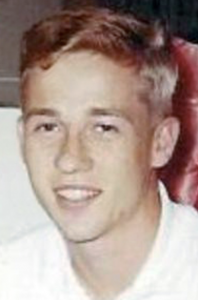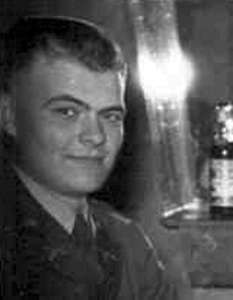
Donald Paul McGrane, age 24, from Waverly, Iowa, Bremer county.
Service era: Vietnam
Parent: Don McGrane
Spouse: Karen (married May 17, 1963)
Children: Shannon and Daniel
Date of death: Wednesday, July 19, 1967
Death details: Hostile, missing in South Vietnam; Navy Lt. Dennis W. Peterson of Huntington Park, Calif., was the pilot of a SH-3A helicopter that crashed in Ha Nam Province, North Vietnam. Peterson was accounted for on March 30, 2012. Also, aboard the aircraft was Ensign Donald P. Frye of Los Angeles, Calif.; Aviation Antisubmarine Warfare Technicians William B. Jackson of Stockdale, Texas; and Donald P. McGrane of Waverly, Iowa. The crew were buried, as a group, on May 2, 2013 at Arlington National Cemetery. On July 19, 1967, the four servicemen took off from the USS Hornet aboard an SH-3A Sea King helicopter, on a search and rescue mission looking for a downed pilot in Ha Nam Province, North Vietnam. During the mission, an enemy concealed 37mm gun position targeted the helicopter as it flew in. The helicopter was hit by the anti-aircraft gunfire, causing the aircraft to lose control, catch fire and crash, killing all four servicemen. In October 1982, the Socialist Republic of Vietnam (S.R.V.) repatriated five boxes of remains to U.S. officials. In 2009, the remains within the boxes were identified as Frye, Jackson, and McGrane. In 1993, a joint U.S./S.R.V. team, investigated a loss in Ha Nam Province. The team interviewed local villagers who identified possible burial sites linked to the loss. One local claimed to have buried two of the crewmen near the wreckage, but indicated that both graves had subsequently been exhumed. Between 1994 and 2000, three joint U.S./S.R.V. teams excavated the previous site and recovered human remains and aircraft wreckage that correlated to the crew’s SH-3A helicopter. In 2000, U.S. personnel excavated the crash site recovering additional remains. Analysis from the Joint POW/MIA Command Central Identification Laboratory subsequently designated these additional remains as the co-mingled remains of all four crewmen, including Peterson.
Cemetery: Arlington National
Source: National Archives, Department of Defense

 Death details: On July 5, 1950, Task Force Smith, the first U.S. ground element to engage North Korean People’s Army (NKPA) troops, was defending a position north of Osan, South Korea. The Task Force’s goal was to delay enemy forces by blocking their movement down the road south from Suwon to Taejon, which was a major avenue of advance for the NKPA. That morning, the Task Force was engaged by a column of enemy tanks. The anti-tank weapons that the infantrymen employed were ineffective, and a large number of tanks broke through their position. Task Force Smith was forced to withdraw to the south, suffering heavy casualties in the process. First Lieutenant Robert Clarence Niemann, who joined the U.S. Army from Iowa, served with C Company, 1st Battalion, 21st Infantry Regiment, 24th Infantry Division. His unit was part of Task Force Smith, and he was captured by enemy forces on July 5. He was marched north to a temporary prison in a schoolhouse in Pyongyang, where he died of dysentery on an unspecified day in mid-August. When U.S. forces gained control of Pyongyang in October, they buried 1LT Niemann in a temporary United Nations cemetery there; however, Pyongyang was retaken by enemy forces in December, and U.S. forces did not gain control the city again. After the ceasefire, 1LT Niemann’s remains were not identified among those returned to U.S. custody. Today, First Lieutenant Niemann is memorialized on the Courts of the Missing at the National Memorial Cemetery of the Pacific.
Death details: On July 5, 1950, Task Force Smith, the first U.S. ground element to engage North Korean People’s Army (NKPA) troops, was defending a position north of Osan, South Korea. The Task Force’s goal was to delay enemy forces by blocking their movement down the road south from Suwon to Taejon, which was a major avenue of advance for the NKPA. That morning, the Task Force was engaged by a column of enemy tanks. The anti-tank weapons that the infantrymen employed were ineffective, and a large number of tanks broke through their position. Task Force Smith was forced to withdraw to the south, suffering heavy casualties in the process. First Lieutenant Robert Clarence Niemann, who joined the U.S. Army from Iowa, served with C Company, 1st Battalion, 21st Infantry Regiment, 24th Infantry Division. His unit was part of Task Force Smith, and he was captured by enemy forces on July 5. He was marched north to a temporary prison in a schoolhouse in Pyongyang, where he died of dysentery on an unspecified day in mid-August. When U.S. forces gained control of Pyongyang in October, they buried 1LT Niemann in a temporary United Nations cemetery there; however, Pyongyang was retaken by enemy forces in December, and U.S. forces did not gain control the city again. After the ceasefire, 1LT Niemann’s remains were not identified among those returned to U.S. custody. Today, First Lieutenant Niemann is memorialized on the Courts of the Missing at the National Memorial Cemetery of the Pacific.